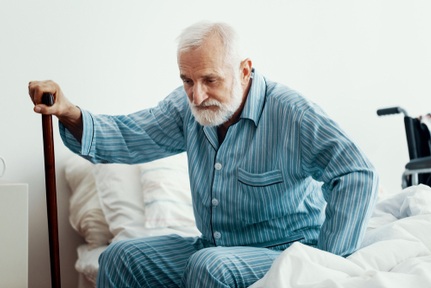Older people's falls reduced by 43% thanks to checklist used in 84 care homes
A three-year study involving 1,657 residents in 84 care homes across England has led to a checklist which has reduced residents’ falls by 43 per cent. 
Academics at Nottingham University worked with care home workers and residents to deliver staff training and a 33-point checklist for all workers to help limit the risk of falls amongst their residents.
The GtACH programme included one hour of training by a falls specialist for all care home staff - including gardeners, caretakers, cooks, cleaners and managers.
The results of the study, published in the BMJ, revealed the GtACH programme reduced the rate of falls when compared to residents who received the usual care, but there was no detrimental decline in residents' activity or rise in dependency on staff as a result.
Lead author of the study Professor Pip Logan, from the Centre for Rehabilitation and Ageing Research at Nottingham University, said: “Falls are common in older residents of care homes and are associated with high risk of injury, admissions to hospital, and important cost to healthcare systems.
“Interventions in care homes tend to be more effective if they are co-designed with residents and staff and take account of the care home context."
Assessing reason for fall such as dehydration leads to staff giving more drinks
Once staff training is delivered, a manual summarising the GtACH programme is left in the care home. It includes material such as a falls incident chart to detect patterns and a drug falls risk chart. Once trained, staff are expected to use the GtACH risk assessment and checklist for all residents.
For example, the assessment might highlight that a resident is dehydrated and the recommended action is to increase fluid intake. The manual and training prompts care home staff to take action for the dehydration, such as introducing smoothies, offering fruit juice more often, adapting crockery to take account of disabilities, producing soups, and making a social event of ‘coffee time’.
Academics found staff training and resources increased ‘both awareness and knowledge about the management of falls’.
The study concluded that a falls prevention programme in care homes for older people 'co-designed with care home staff and residents, that involved awareness raising, education, screening, decision support, and implementation support was associated with a reduction in falls rate’.
Recruitment of care home residents for the study took place between 1 November 2016 and 31 January 2018. The average age of residents taking part in the study was 85-years-old and two thirds of residents were women.
All residents in the 84 care homes could participate, including those who lacked mental capacity to provide consent but residents who were in the last few days of life, were excluded from the study.
Professor Pip Logan added: “We thank the nursing home managers, staff, residents, and informal carers who generously gave their time and participated in the study.
“We consider that training 71 per cent of care home staff was a success, given that such staff often work part time or out of office hours, and given the extent of staff turnover in the care home sector”.
Latest News
 29-Jul-24
Dementia Bus gives carehome.co.uk staff insight into life with dementia
29-Jul-24
Dementia Bus gives carehome.co.uk staff insight into life with dementia
 01-Mar-24
Find out the top care homes in 2024
01-Mar-24
Find out the top care homes in 2024
 21-Mar-23
UK's top care homes in 2023 revealed
21-Mar-23
UK's top care homes in 2023 revealed
 03-Jan-23
carehome.co.uk launches free care helpline
03-Jan-23
carehome.co.uk launches free care helpline
 13-Dec-22
5 mins with Emily Whitehurst, chief operating officer for Constantia Healthcare
13-Dec-22
5 mins with Emily Whitehurst, chief operating officer for Constantia Healthcare